Application of Organic Fertilizer to Increase the Productivity of Tiger Shrimp Rice Cultivation in Brackish Water Affected Land With the Coculture System
Abstract
Unproductive land affected by brackish water is a global challenge, particularly in aquaculture and agriculture; it has certain limitations that can hinder its use economically or ecologically, so it requires proper management to become more valuable and useful. This study evaluates the effectiveness of powdered and liquid organic fertilizers (LOFs) in a coculture system integrating rice and tiger shrimp cultivation on brackish water-affected land. The experiment was conducted on 12 pond plots, each measuring 560 cm2, with four treatments: (a) LOF; (b) powdered organic fertilizer (POF); (c) a combination of liquid and POFs (LPOFs); and (d) no fertilizer (NF). Observed parameters included rice plant growth, tiger shrimp growth and survival rates, and water quality, measured every 14 days. The findings revealed that the highest growth and survival rates of tiger shrimp (8.48 g/individual and 76%, respectively) were achieved with LPOF treatment. In comparison, the lowest growth and survival rates (4.84 g/individual and 37%) occurred without fertilizer. Tiger shrimp weight increased significantly over 70 days, from an initial average of 0.2–8.48 g/individual (LPOF) and 6.58 g/individual (NF); likewise, the rice plant grows well during 105 days of maintenance. Organic fertilizer applications proved beneficial for rice and shrimp, enhancing plankton growth and serving as a natural feed source for shrimp. This reciprocal relationship demonstrates the potential of organic fertilizers to boost productivity and sustainability in rice-shrimp coculture systems. This research offers valuable insights and practical strategies to overcome the challenges faced by tiger shrimp farmers in brackish water aquaculture.
1. Introduction
Aquaculture plays a crucial role in the blue economy and is a critical component of the global food production system [1]. Among the various aquaculture practices, pond-based aquaculture is one of the most dominant methods, particularly in Asia [1], and has even spread worldwide [2]. Shrimp farming significantly contributes to various countries, becoming an essential fishing industry sector and providing a high protein source from the aquaculture sector [3, 4]. The multibillion-dollar shrimp farming industry. It is a massive source of income in Asia and South America, contributing to substantial employment opportunities [5, 6].
Tiger shrimp is one of the most cultivated species worldwide; its production reached 711,075 tons, accounting for approximately 12%–15% of global shrimp production. In 2018, its market value reached 7.35 billion USD [7]. The contribution of tiger shrimp farming is expanding widely at various scales. It has traditionally been a significant source of income for many farmers in coastal areas with access to brackish water, particularly in tropical countries [8].
Integrated cultivation activities involving rice, tiger shrimp, and other commodities have been widely implemented worldwide [2–4]. Culturing rice alongside others has been conducted using various models [5–9]. Mutualism is observed within this cultivation system [10]. Using fertilizers is a crucial aspect of these activities [11–14]. Fertilizer types and application patterns also significantly influence the crayfish farming coculture system [14].
Fertilizers employed in rice cultivation and aquatic species, such as tiger shrimp within brackish water coculture systems, are emerging as productive and sustainable alternatives for cultivation practices [10]. Organic fertilizers are recognized as a sustainable and environmentally friendly source of nutrients [15–17]. Applying organic fertilizers can enhance land productivity in rice and tiger shrimp cultivation by providing essential nutrients for both crops [10]. This study shows that the soil’s organic carbon and carbohydrate content significantly increase when applying organic fertilizers in conventional and organic rice-crab coculture systems [18].
Biofertilizers and organic matter can improve soil structure, increase microbial diversity, enhance nutrient availability, and support plant growth [14]. Proper organic fertilizer formulations are necessary to support the development of rice and tiger shrimp in coculture cultivation systems on brackish water land, ensuring a balanced supply of nutrients for both species. Ideally, organic fertilizers should contain macro and micronutrients essential for rice growth while contributing to soil fertility, maintaining water quality, promoting the health of tiger shrimp, and encouraging sustainable agricultural practices [14, 19].
However, complete data have not been found on the use of liquid and powdered organic fertilizers (LPOFs) in the cultivation of rice and tiger shrimp plants in an integrated manner. Studies on using organic fertilizers in rice cultivation and tiger shrimp in coculture systems have not been found in brackish water intrusive lands. This research is essential to understand the benefits and potential use of organic fertilizers in tiger shrimp rice cultivation with a coculture system on land affected by brackish water [20]. The use of organic fertilizers plays a role; it contributes to the development of more efficient and sustainable methods for tiger shrimp rice cultivation [10], adding productivity to tiger shrimp rice farming [15, 21].
This study aims to evaluate the use of organic fertilizers “eco-farming” (powdered fertilizer containing C-organic elements, nitrate, P2O5, K2O, and liquid organic fertilizer [LOF] containing N, P, K, Ca, Mg, Cu, Zn, Mn, Fe) to increase the productivity of tiger shrimp rice cultivation with brackishwater coculture system in brackish water-affected land. The research results can be used as a basis and practice for the development of better rice and tiger shrimp cultivation in the aquaculture industry.
2. Materials and Methods
2.1. Site Selection and Land Preparation
This research was conducted at the Experimental Pond Installation of the Brackish Water Aquaculture Research Institute, Maros, South Sulawesi, under the Indonesian Ministry of Marine Affairs and Fisheries. The rice fields and ponds in the area had not been utilized for rice cultivation for an extended period due to seawater intrusion, which reduced their productivity. The brackish water-infested land was reconstructed using a mini tractor into rice paddies and caren.
2.2. Experimental Design
The study utilized 12 plots (caren), each measuring 560 m2. A complete randomized design (CRD) was employed, consisting of four treatments: (A) LOF, (B) powdered organic fertilizer (POF), (C) a combination of LPOFs, and (D) no fertilizer (NF). Each treatment was replicated three times. The composition of the powdered fertilizer is as follows: C-organic 51.06%; C/N ratio 15.24; total N 3.35%; total P2O5 4.84%; total K2O 1.47%; moisture content 15.32%; and pH 7.05. LOFs contain essential elements, including N, P, K, Ca, Mg, Cu, Zn, Mn, and Fe.
2.3. Application of Organic Fertilizers
Cultivation using liquid and solid organic fertilizers was conducted three times: during soil tillage, when planting, and when the rice was 65 days old. Selection of LPOFs according to the needs of plants and tiger shrimp. Providing tools in buckets, spoons, and sprayers, mixing LPOFs according to the dosage of 15:15 g. Application of LPOF to rice plants in rice fields and caren with predetermined doses (Figure 1).
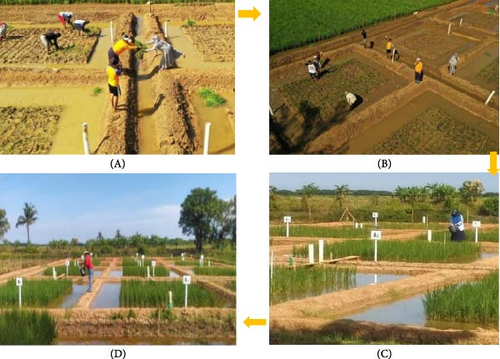
2.4. Rice and Tiger Shrimp Cultivation
Rice variety Inpari 34 was cultivated in the paddy field for 105 days, while shrimp (Penaeus monodon) were reared in a caren. Seeds with salinity tolerance of 5–7 ppt were sown in an area of 2 × 5 m2 after soaking and storage until germination, followed by a 25-day maintenance period. Each plot was planted with rice seeds and post larvae (PL14) at a density of 4 individual/m2. After 25 days in the nursery, the rice was transplanted using the Legowo planting system (25 × 12 × 40 cm), see Figure 1. Shrimp larvae (PL40) were released 14 days after rice planting to avoid heat stress, using freshwater from the surrounding canal to control salinity.
2.5. Shrimp Performance Evaluation
The observed tiger shrimp growth parameter is the increase in body weight. The weight of the shrimp was measured using an electric scale with an accuracy of 0.01 g. The sample (30 shrimp) was monitored for growth performance at 14-day intervals. Tiger shrimp survival and production rates were observed at the end of the study.
2.6. Water Quality Parameters
Water quality parameters are observed every 14 days: pH, salinity, dissolved oxygen, and alkalinity. The concentrations of ammonia, nitrite, nitrate, and phosphate were analyzed using the spectrophotometer method (Shimadzu, UV 2550) and the alkalinity titration method, according to the process [20].
2.7. Data Analysis
The data was analyzed using analysis of variance (ANOVA) and the Tukey test.
2.8. Ethical Treatment of Test Animals
This study follows ethical care guidelines for the care and use of test animals. This study follows the experimental operational standards of Penaeus monodon shrimp at the Brackish Water Aquaculture Research Center, Marine and Fisheries Research and Human Resources Agency, Republic of Indonesia.
3. Results
3.1. Performance of Rice Plant Growth
The performance of rice plants can be seen in Figure 2. They seem to thrive, characterized by the appearance of green leaves and upright rice trees. The average height of rice plants transferred to the rice field on the 25th planting day is 42 cm. At the age of 39 days after planting (DAP), the height of the rice plant increased in all treatments: (a) 57 cm, (b) 60 cm, (c) 69 cm, and (d) 50 cm. In Figure 3A, plant height varies with each treatment, with the highest increase in the LPOF treatment, which continues with the maintenance age. At 53 DAP, the rice plant grows taller, and the formation of grains begins at age 67. Full maturity is reached at the age of 105 DAP, marked by the yellowing of the rice grains, and is ready to be harvested. The highest growth, 147 ± 42 cm, was recorded in LPOF treatment; meanwhile, the increase in the height of rice plants is lowest in nonfertilizer treatment, with an initial planting height of 45–50 cm (D), 57 cm (A), 60 cm (B), and 69 cm (C).
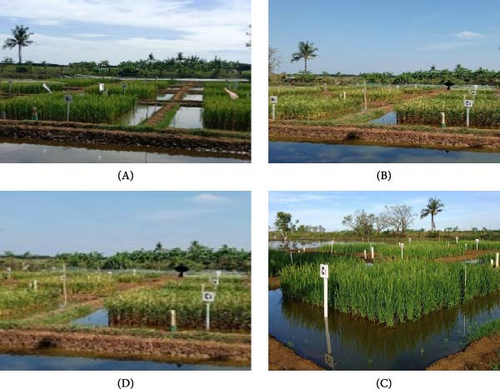
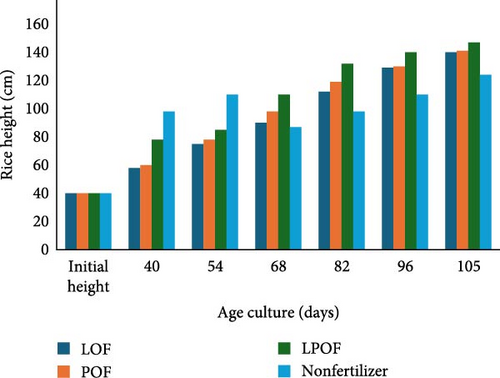
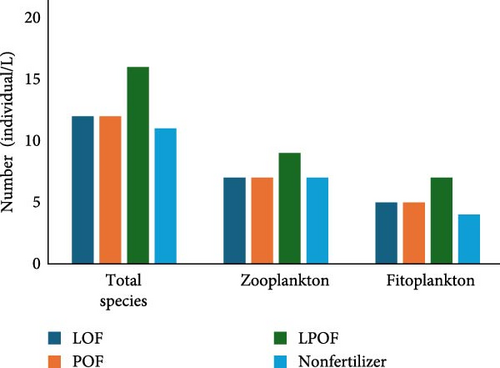
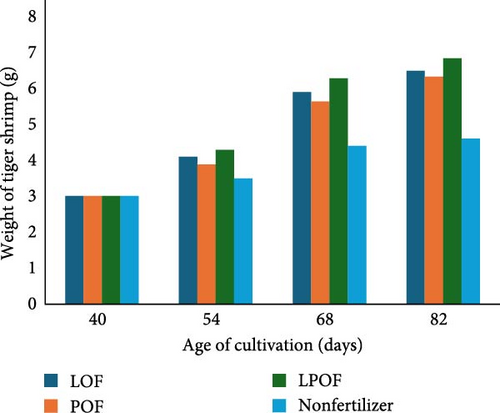
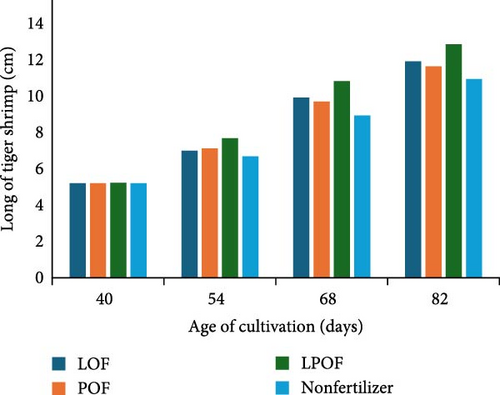
3.2. The Weight and Length Gain of Tiger Shrimp
The weight and length gain of tiger shrimp are different in each treatment (Figure 3C,D). In Figure 3C, the initial weight of tiger shrimp stocked in the caren is 3.08 g/individual. Weight gain with the age of cultivation, at 54 days, the LOF treatment is 4.1 g/individual, POF is 3.8 g/individual, LPOF is 4.29 g/individual, and nonfertilizer is 3.49 g/individual. Furthermore, at the age of 68 days, the weight of tiger shrimp becomes 5.9 g/individual (LOF), 5.64 g/individual (LOF), 6.28 g/individual (LPOF) and nonfertilizer 4.4 g/individual. At the age of 82 days, the weight of tiger shrimp in LOF became 6.49 g/individual, 6.33 g/individual in POF, 6.84 g/individual in LPOF, and only 4.6 g/individual in nonfertilizer treatment. The growth of shrimp in treatment (LPOF) was the highest, with an average of 8.41 g/individual.
Treatment (POF) and (LOF) showed significantly unchanged shrimp growth, 7.740 g/individual, respectively and 7.63 g/individual; control (NF) resulted in the lowest shrimp growth, 6.58 g/individual. Survival rate: LPOF treatment has the highest survival rate of shrimp, 76%. Treatment B (POF) and treatment C (LOF) have survival rates of 59% and 56%, respectively; control (without fertilizer) produced the lowest shrimp survival rate, 37%. This data shows that using a mixture of powdered and LOF (LPOF) provides the best results in supporting the growth and survival of tiger shrimp cultivated in coculture with Inpari 34 saline-tolerant rice. Figure 3C shows the tiger shrimp’s weight gain trend in coculture with Inpari 34 rice, using LPOFs.
Research data shows that the weight and length of shrimp increase with the age of cultivation at Figure 3C,D. At 54 days of age, LPOF treatment produced shrimp weighing 4.29 g/individual, the highest compared to other treatments. At 68 days of age, shrimp weight was very significant, with LOF reaching 5.9 g/individual, POF 5.64 g/individual, and the highest LPOF 6.29 g/individual. At 82 days of age, shrimp weight increased, with LPOF reaching 6.84 g/individual, followed by LOF 6.49 g/individual, POF 6.33 g/individual, and lowest NF 4.60 g/individual. Harvesting is carried out at that age, considering that it has entered the peak of growth, avoiding mortality caused by disease factors, environmental stress, or food competition, and optimizing crop yields.
Fertilizer use significantly affected shrimp growth, with LPOF showing the highest impact, while NF treatment resulted in the lowest shrimp weight at each observation stage. Overall, the graph shows that using a mixture of LPOF in the rice-shrimp cultivation system supports tiger shrimp’s growth better than other treatments, especially without fertilizer. This condition can be the basis for optimizing tiger shrimp cultivation using liquid and powder.
The results in Table 1 show the average growth of tiger shrimp as a final growth after 65 days of cultivation between treatments: control 6.58 ± 0.14, LOF 7.63 ± 0.09, POF 7.74 ± 2.42, and LPOF 8.41 ± 2.33. LOF and POF values are similar, while LPOF and NF differ significantly. LPOFs positively impacted growth rates and better survival, while those without fertilizers (controls) showed the lowest values.
| Treatment | Growth rate (g/individual) | Survival rate (%) |
|---|---|---|
| Powder fertilizer (POF) | 7.63 ± 0.09b | 56 ± 2.09b |
| Liquid fertilizer (LOF) | 7.74 ± 2.42b | 59 ± 2.36b |
| Liquid powder fertilizer (LPOF) | 8.41 ± 2.33c | 70 ± 2.15c |
| Nonfertilizer (control) | 6.58 ± 0.14a | 37 ± 0.11a |
- Note: Average ± S.D.
- a indicates the lowest value, namely in the treatment of non fertilizer (NF).
- b indicates no difference between the POF treatment and the LOF.
- c indicates the highest value among all treatments, namely LPOF.
Table 2 indicates that the use of LPOFs in brackish water aquaculture systems enhances the production of rice and tiger shrimp, with the LPOF yielding the highest production; the average rice yield is 3.1 kg/pond (1.3 t/ha) for LOF, 2.7 kg/pond (1.2 t/ha) for POF, 5 kg/pond (3 t/ha) for LPOF and 1.5 kg/pond (0.9 t/ha) for NF. In comparison, the highest tiger shrimp production under LPOF reaches 5 kg/pond (0.086 t/ha), and the lowest under NF is 2.54 kg/pond.
| Parameters | Liquid organic fertilizer (LOF) | Powder organic fertilizer (POF) | Liquid powder fertilizer (LPOF) | Non-fertilizer (NF) |
|---|---|---|---|---|
| Grain production (kg/pond) | 3.1 ± 4.26b | 2.7 ± 4.26b | 5 ± 4.26c | 1.5 ± 4.26a |
| Grain production (t/ha) | 1.3 ± 4.26b | 1.2 ± 4.26b | 3 ± 4.26c | 0.9 ± 4.26a |
| Shrimp production (kg/pond) | 3.92 ± 6.66b | 3.8 ± 4.26b | 5 ± 4.26c | 2.54 ± 4.24a |
| Shrimp production (t/ha) | 0.06 ± 0.01b | 0.07 ± 0.013b | 0.086 ± 2.2c | 0.013 ± 010a |
- a in non fertilizer (NF) indicates the lowest value of the entire treatment.
- b in LOF and POF shows values that are not much different from the two treatments.
- c on the LPOF indicates the highest value of all treatments.
The highest production of rice and tiger shrimp was achieved with the LPOF treatment (a combination of LPOFs), while LOF and POF treatments also increased production, albeit to a lesser extent; the treatment without organic fertilizer (NF) resulted in the lowest production levels. Liquid fertilizers contain N, P, K, Ca, Mg, Cu, Zn, Mn, and Fe, which support nutrient availability and plant growth and help reduce environmental stress.
Table 2 shows that the combination of LPOFs significantly outperforms other treatments, with higher results compared to single fertilizer applications in integrated rice and tiger shrimp cultivation; average production values indicate that LPOF treatment results in higher rice yields than LOF, while POF is lowest under NF conditions, highlighting the positive impact of combined fertilizers on both commodities. Using powdered and liquid fertilizers can increase the growth of rice and tiger shrimp in brackish water-infested land. Powdered fertilizers, with a high C-organic content (51.06%), improve soil fertility and structure and reduce the impact of brackish water. The content of N-total (3.35%), P2O5-total (4.84%), and K2O-total (1.47%) increased the availability of nutrients.
3.3. The Number of Species and Density of Plankton
Figure 3B shows the number of plankton species in each treatment. The number of plankton species in the LPOF treatment was 16 types, consisting of 9 zooplankton species and 7 phytoplankton species, with a density of 5.2554 cells/m2. In LOF and POF, there are 12 species, namely 5 species of phytoplankton and 7 species of zooplankton; the density is calculated at 2570 and 2645 cells/m2, while NF is only 11 species, namely 4 phytoplankton and 7 species of zooplankton, with a density of 1250 cells/m2. In LPOF, the number of species is highest, as is the density of total plankton, both phytoplankton and zooplankton. The combination of liquid and powder fertilizers in these cultivation conditions has a good influence on the emergence of some more significant species. The number of species and total plankton affect the growth of rice and tiger shrimp in caren.
3.4. Water Quality
The water quality parameters listed in Table 3 show that the highest acidity level is found in LPOF, with pH ranging from 7.51 to 9.12. The water temperature varied between 25.5–31.1°C at different treatments. At the same time, salinity ranged from 0 to 6.3 ppt at POF and reached a maximum of 7 ppt in the tolerance range of Inpari 34 rice varieties and tiger shrimp.
| Parameters | Treatment | |||
|---|---|---|---|---|
| Liquid organic fertilizer (LOF) | Powder organic fertilizer (POF) | Liquid and powder organic fertilizer (LPOF) | Nonfertilizer (NF) | |
| pH | 7.5–7.6 | 7.5–8.9 | 7.51–9.12 | 7.1–8.8 |
| Temperature (°C) | 28.7–31 | 28.3 – 31.1 | 20.4–30.3 | 25.5–30.9 |
| Salinity (ppt) | 0–6.3 | 1–53 | 0.66–6.24 | 0–6 |
| Alkalinity (mg/L) | 58–165 | 28–162 | 17–162 | 41–161 |
| Dissolved oxygen (mg/L) | 2.8–8.7 | 2.5–7.8 | 2.8–9.6 | 2.7–7.9 |
| Nitrate, NO3-N (mg/L) | 0.011–0.6039 | 0.0206–0.3471 | 0.0209–1.4663 | 0.0258–0.2913 |
| Nitrite, NO2-N (mg/L) | 0.008–0.0231 | 0.0087–0.0245 | 0.0057–0.0271 | 0.008–0.0155 |
| Posfat, PO4-P (mg/L) | 0.0094–0.2509 | 0.0101–0.0467 | 0.0057–0.3362 | 0.0129–0.1717 |
| Ammonia, NH3-N (mg/L) | 0.0452–0.3120 | 0.0351–0.384 | 0.0481–0.3089 | 0.0349–0.3625 |
Dissolved oxygen levels ranged from 2.8 to 9.6 mg/L in LPOF, 2.5–8.7 mg/L in POF, 2.8–8.7 mg/L in LOF, and 2.7–7.9 mg/L in NF, with LPOF having the highest stability. The nitrate and phosphate content were also highest in LPOF (0.0209–1.4663 mg/L and 0.0057–0.3362 mg/L). Ammonia levels were similar across all treatments, while nitrite was lowest in LPOF and highest in NF. LPOF shows better nutritional stability compared to LOF, POF, and NF.
4. Discussion
The performance of rice plants grows well with the application of LPOFs and better with a mix. The growth trend of the Inpari 34 rice variety in the tiger shrimp coculture system with LPOF is better than other treatments. Given the environmental impact of chemical fertilizers in rice monoculture systems, it is essential to adopt sustainable practices by integrating rice cultivation and diverse commodities [10, 22].
The application of LOF, POF, and NF resulted in increased plant height corresponding to the age of the culture across all treatments. Notably, the LPOF treatment, assumed to be the primary treatment, exhibited the highest growth compared to the other treatments at each observation stage. The disparity in plant height among the treatments became more pronounced with increasing culture age, indicating that the treatment had a significant impact on plant growth [7, 11, 23, 24].
A good environment is available for aquatic animals, so animal activity increases in the rice fields, helps prey on rice pests, improves soil nutrients, and promotes the growth of rice plants [5, 7, 18]. The efficiency of nutrient use in aquaculture increases with the activity of aquatic animals that encourage the nutrient cycle so that there is a complementary use of nutrients between rice plants and marine animals [10, 25]. The coculture cultivation system increases adequate rice yields by optimizing the use of nutrients in cultivated land; co-living, rice, and aquatic organisms can complement each other [10], can reduce fish feed inputs, maintain sustainable soil sanitation, and reduce environmental pollution [4, 26].
The growth of rice plants is optimal in the fields, with LOF and POF treatments, particularly LPOF, demonstrating even better growth effects. Organic fertilizers are increasingly becoming a trend in agricultural practices across various segments of cultivation activities [27, 28]. Organic fertilizers have been widely applied in various aquaculture commodities. When applied to rice and tiger shrimp in a co-culture system, it significantly improves productivity and quality of the cultivation environment [10], has the potential to provide benefits for rice plants, and increases nutrient absorption and fertilizer use efficiency, which has an impact on increasing crop yields [29]. The use of liquid and solid organic fertilizers increases the nutrition and productivity of rice by absorbing nutrients more effectively and trophic relationships of soil and plant microorganisms [30, 31]. The growth of Inpari 34 rice carried out using LPOF showed significant results in improving the quality and quantity of production. Previous research using nitrogen fertilizer increases anthocyanins in rice leaves [32]. In recent years, research has been conducted to improve the efficiency and sustainability of agriculture by using a coculture system [5, 25, 33], which involves the simultaneous growth of rice and aquatic animals [24, 34, 35].
The data showed a growth trend for all variables, indicating that the coculture system of tiger shrimp with LOF and powder was able to support the growth of rice plants well. The use of LPOFs in the culture system with rice and aquatic animals is a model for the development of productive and environmentally friendly [4, 10, 25, 36].
The application of LPOF resulted in a higher presence of plankton species, suggesting an increase in nutrient content associated with using organic fertilizers. Fertilizers enriched with nitrogen and phosphorus nutrients promote the growth and productivity of phytoplankton, leading to elevated levels of organic matter phosphate in soils treated with organic fertilizers compared to those without fertilizer applications [31, 37].
The existence of various species and the total density of phytoplankton and zooplankton signify effective nutrient stimulation at the cultivation site. This finding aligns with prior studies involving nitrogen-rich fertilizers. Nitrogen fertilizers can positively impact specific varieties by enhancing anthocyanin synthesis, utilizing phenylalanine as a precursor to promote the biosynthetic pathway [11, 32].
The results showed that the treatment of LPOF and NF was significantly different, while the values of LOP and POF were not much different. Using LPOFs in integrated cultivation can increase land fertility with the efficiency of nutrient utilization from the fertilizer, so that the growth rate and survival rate value of tiger shrimp are better [38, 39].
The growth of tiger shrimp in each treatment looks good; in LOF and POF treatments, even the highest growth is obtained in LPOF treatment, while the growth of tiger shrimp in NF treatment is the lowest. LPOFs can improve nutrients for rice and tiger shrimp, improving their growth and productivity [3, 14, 40–42]. Integrated rice and shrimp cultivation practices and organic fertilizer inputs have been carried out in several locations, such as the Mekong Delta, with better results [4, 43–45].
The application of LOFs with N-total (3.35%), P2O5-total (4.84%), and K2O-total (1.47%) content, as well as powdered fertilizers with elements N, P, K, Ca, Mg, Cu, Zn, Mn, and Fe in rice and aquatic animal coculture systems, supports the availability of nutrients and plant growth, and helps reduce environmental stress in particular, these fertilizers can reduce dependance on pesticides and herbicides, which can damage the environment. In addition, LPOFs contribute to increased soil fertility and improved water quality [46, 47].
In previous studies, there was a high soil nutrient surplus, and NO3-N accumulation increased with excessive use of chemical fertilizers [12], which can cause fruit quality to be inhibited and nutrient absorption and utilization to be inhibited [12, 42]. Fertilizer application is expected to cause dynamism of soil enzyme activity assisted by comprehensive regulation of groundwater, plant species, and other factors [16, 48].
Overall, this data shows that using a mixture of LPOF best supports the growth and survival of tiger shrimp cultivated in coculture with Inpari 34 rice [49]. Based on the available data, the dissolved oxygen level in LPOF was slightly higher, reaching 9.6 mg/L. This condition looks better than other treatments [3, 50].
The LPOF treatment showed higher availability of nutrients, especially nitrates, as well as ammonia stability and decreased nitrite concentrations. These quality parameters favor the growth of tiger shrimp, especially in LPOF treatment, which results in improved growth performance. Overall, LPOF exhibits superior characteristics compared to the treatment of LOF, POF, and NF, with more stable and optimal levels of dissolved oxygen, nutrients, and ammonia and lower nitrite content [51, 52].
LPOFs play a specific role in increasing the growth of rice and tiger shrimp through the ability of the soil to absorb water and nutrients, increase the availability of nutrients, and reduce environmental stress, as well as increase soil fertility and reduce the impact of brackish water. Organic fertilizers improve the physical properties of the soil, such as aggregation and distribution of pore size, as well as reducing compaction. This improves the retention and transmission of groundwater, which is crucial for plant growth [53–55].
5. Conclusion
Utilizing LPOFs in the cultivation of tiger shrimp and rice within a brackish water co-culture system on degraded brackish land can markedly enhance the growth and yield of Inpari 34 rice and tiger shrimp compared to nonfertilized conditions. This approach supports the productivity and sustainability of integrated rice and tiger shrimp cultivation, establishing a foundation for developing such systems through organic fertilizer application. The findings offer valuable insights and alternative strategies for shrimp farmers dealing with challenges related to aquaculture productivity.
Ethics Statement
This study has obtained ethical approval from the Research Ethics Committee (REC) of Universitas Muslim Indonesia (Number: UMI022505373).
Conflicts of Interest
The authors declare no conflicts of interest.
Author Contributions
Sahabuddin Sahabuddin: conceptualization, data curation, formal analysis, funding acquisition, investigation, methodology, validation, visualization, writing – original draft, writing – review and editing. Early Septiningsih: data curation, formal analysis, funding acquisition, methodology, project administration, validation. Kurniah Kurniah: data curation, formal analysis, investigation, project administration, resources. Erfan Andi Hendrajat: formal analysis, funding acquisition, investigation, project administration, resources, validation. Andi Sahrijanna: data curation, funding acquisition, investigation, methodology, resources. Mat Fahrur: data curation, formal analysis, project administration, resources, visualization. Hidayat Suryanto Suwoyo: data curation, formal analysis, funding acquisition, methodology, validation, writing – review and editing. Muslimin Muslimin: funding acquisition, resources, visualization. Nurbaya Nurbaya: funding acquisition, resources, validation. Herlinah Herlinah: data curation, formal analysis, funding acquisition, writing – review and editing. Endang Susianingsih: data curation, funding acquisition, project administration, validation, writing – review and editing. Sitti Faridah: funding acquisition, investigation, project administration, visualization. Rosmiati Rosmiati: data curation, formal analysis, funding acquisition, validation, writing – review and editing. Ahmad Musa: funding acquisition, project administration, visualization. Anna Safarrida: funding acquisition, resources, validation. Eny Dyah Yuniwati: formal analysis, investigation, writing – review and editing. Rahmadi Tambaru: formal analysis, funding acquisition, writing – review and editing.
Funding
This research the Research Center for Brackish Water Aquaculture and Fisheries Extension, Fisheries Research Center, Ministry of Maritime Affairs and Fisheries, Republic of Indonesia.
Acknowledgments
The authors thank the field team: Abdul Gappar, Saparuddin, Hariani, Sitti Rohani, and Daeng Muda, who have helped with rice and shrimp maintenance at the research site, and the laboratory team, who have helped analyze the water and soil quality in the laboratory. English grammar correction has been done using Grammarly Premium, as well as DeepL Write’s assistance in the preparation of revised manuscripts.
Open Research
Data Availability Statement
The data that support the findings of this study are available upon request from the corresponding author. The data are not publicly available due to privacy or ethical restrictions.




